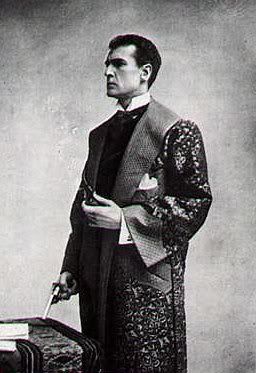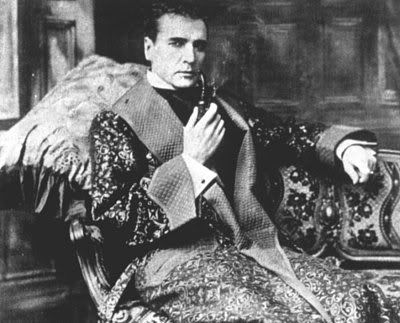
William Gillette (1853-1937)
There are plenty of pictures of various people who portrayed Sherlock Holmes through the years, all of who can legitimately be refered to as pipe smokers: Jeremy Brett, Peter Cushing, Basil Rathbone. But before them all there was William Gillette.
Gillette was born (and died, by the way) in Hartford, Connecticut. There were two men to portray Holmes on stage before Gillette, but they both did it only once and they are pretty much forgotten now (their names were Charles Brookfield and John Webb). However, Gillette was, and is, considered the definitive "Holmes on stage."
He was not only an actor, but a playwright and stage manager. Arthur Conan Doyle, after writing the final Holmes tale in 1893, decided to make more money by taking Holmes to the stage. He wrote a five-act play and took it to some producers who wanted to change the Holmes character too much (they wanted to introduce a love interest--typical). So he turned them down and went looking for someone else. Eventually he connected with Gillette.
Gillette did change Holmes somewhat. He portrayed a Holmes that was much more open and less emotionally repressed than the story-book Holmes, but he didn't go so far as to actually have him in a relationship. He re-wrote Conan Doyle's original play as a shorter four-act version, and in modern parlance, it was a smash hit--although it was not particularly praised by critics of the time (again--typical). He continued to perform the play Sherlock Holmes - A Drama in Four Acts for the rest of his life, putting on some 1,300 shows during the course of 34 years.
It was Gillette who originally introduced the apocryphal and non-canonical phrase "Oh, this is elementary, my dear Watson," which was later shortened to the familiar "Elementary, my dear Watson" in numerous movies. Gillette was also responsible for the erroneous image of Holmes with a calabash pipe. He had to use a curved pipe rather than a more authentic straight pipe because it was easier to speak with it. A curved pipe has a lower center of gravity and hangs more comfortably, and is easier to "speak around" without removing it from the mouth. The deeper the bend, the lower the center of gravity. A straight pipe will tend to bounce around somewhat uncontrollably while speaking.

The original script for his play was destroyed in a fire, but he re-wrote it again from memory. He also served as the model for numerous illustrations of Holmes used in periodicals of the time. In 1916, he starred as Holmes in a film version of his play. Of course, it was a silent movie. His play was filmed again in 1922 starring John Barrymore as Holmes. Gillette last portrayed Holmes in his play's final performance in 1932, five years before his death.
And based on what I have read of him, he was a pipe smoker off-stage, as well. Notice the smoke in the above photographs.
Gillette was also known for his enormous castle on the Connecticut River, which he patterned after an ancient Norman castle. It took five years to build, and when it was completed in 1919 it had cost 1 million U.S. dollars (the equivalent of more than 12 million dollars today). He also had a train with a three-mile track that circumnavigated the estate. The castle is now part of Gillette Castle State Park. One of his frequent guests was fellow pipe smoker Albert Einstein. He was also very fond of riding his motorcycle.
William Gillette died of a pulmonary hemorrage in 1937.
I just yesterday bought a book, "Teller of Tales: The Life of Arthur Conan Doyle", by Daniel Stashower, published in 1999. According to him, Gillette did write Holmes with a love interest, and this agrees with the revival I've seen on TV starring Frank Langella as Holmes. Furthermore, the following paragraph should interest you:
ReplyDelete"Legend holds that Gillette also introduced the familiar curved-stem calabash pipe, which was to become such a familiar totem. The actor was himself a dedicated pipe smoker and relished the opportunity to smoke onstage. According to received wisdom, Gillette settled on the calabash because its shape and balance allowed him to 'talk around' the pipe. Actually, there is no evidence that Gillette ever used a calabash, and the pipe's weight would have made it an unwieldy stage prop. Gillette seems to have favored a lighter, bent-stem briar. It has recently been suggested, in the pages of The Baker Street Journal, that the famed calabash may originally come to light as an oversized comedy prop. In a handful of comedy shorts from the 1930s and 1940s, calabashes are found in the hands of Holmes impersonators who did not share Gillette's reverence for the character--such as Abbott and Costello, Robert Woolsey, and the Three Stooges."
Which seems rather circumstantial, either way. If it was not established somewhere (and Gillette was the most famous personator of Holmes, especially in America), why was such an image so widely accepted and recognized?